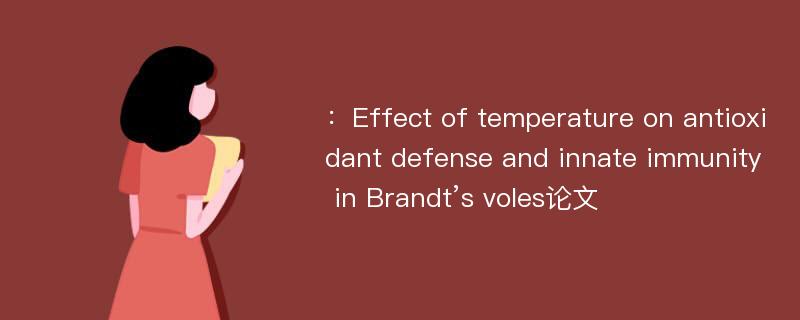
本文主要研究内容
作者(2019)在《Effect of temperature on antioxidant defense and innate immunity in Brandt’s voles》一文中研究指出:Ambient temperature is an important factor influencing many physiological processes, including antioxidant defense and immunity. In the present study, we tested the hypothesis that antioxidant defense and immunity are suppressed by high and low temperature treatment in Brandt’s voles(Lasiopodomys brandtii). Thirty male voles were randomly assigned into different temperature groups(4, 23, and 32 °C, n=10 for each group), with the treatment course lasting for 27 d. Results showed that low temperature increased gross energy intake(GEI) and liver, heart, and kidney mass, but decreased body fat mass and dry carcass mass.With the decline in temperature, hydrogen peroxide(H2O2) concentration, which is indicative of reactive oxygen species(ROS) levels, increased in the liver,decreased in the heart, and was unchanged in the kidney, testis, and small intestine. Lipid peroxidation indicated by malonaldehyde(MDA) content in the liver, heart, kidney, testis, and small intestine did not differ among groups, implying that high and low temperature did not cause oxidative damage.Similarly, superoxide dismutase(SOD) and catalase(CAT) activities and total antioxidant capacity(TAOC) in the five tissues did not respond to low or high temperature, except for elevation of CAT activity in the testis upon cold exposure. Bacteria killing capacity, which is indicative of innate immunity, was nearly suppressed in the 4 °C group in contrast to the 23 °C group, whereas spleen mass and white blood cells were unaffected by temperature treatment. The levels of testosterone, but not corticosterone, were influenced by temperature treatment, though neither were correlated with innate immunity, H2O2 and MDA levels, or SOD, CAT, and TAOC activity in any detected tissues. Overall, these results showed that temperature had different influences on oxidative stress, antioxidant enzymes,and immunity, which depended on the tissues and parameters tested. Up-regulation or maintenance of antioxidant defense might be an important mechanism for voles to survive highly variable environmental temperatures.
Abstract
Ambient temperature is an important factor influencing many physiological processes, including antioxidant defense and immunity. In the present study, we tested the hypothesis that antioxidant defense and immunity are suppressed by high and low temperature treatment in Brandt’s voles(Lasiopodomys brandtii). Thirty male voles were randomly assigned into different temperature groups(4, 23, and 32 °C, n=10 for each group), with the treatment course lasting for 27 d. Results showed that low temperature increased gross energy intake(GEI) and liver, heart, and kidney mass, but decreased body fat mass and dry carcass mass.With the decline in temperature, hydrogen peroxide(H2O2) concentration, which is indicative of reactive oxygen species(ROS) levels, increased in the liver,decreased in the heart, and was unchanged in the kidney, testis, and small intestine. Lipid peroxidation indicated by malonaldehyde(MDA) content in the liver, heart, kidney, testis, and small intestine did not differ among groups, implying that high and low temperature did not cause oxidative damage.Similarly, superoxide dismutase(SOD) and catalase(CAT) activities and total antioxidant capacity(TAOC) in the five tissues did not respond to low or high temperature, except for elevation of CAT activity in the testis upon cold exposure. Bacteria killing capacity, which is indicative of innate immunity, was nearly suppressed in the 4 °C group in contrast to the 23 °C group, whereas spleen mass and white blood cells were unaffected by temperature treatment. The levels of testosterone, but not corticosterone, were influenced by temperature treatment, though neither were correlated with innate immunity, H2O2 and MDA levels, or SOD, CAT, and TAOC activity in any detected tissues. Overall, these results showed that temperature had different influences on oxidative stress, antioxidant enzymes,and immunity, which depended on the tissues and parameters tested. Up-regulation or maintenance of antioxidant defense might be an important mechanism for voles to survive highly variable environmental temperatures.
论文参考文献
论文详细介绍
论文作者分别是来自Zoological Research的,发表于刊物Zoological Research2019年04期论文,是一篇关于,Zoological Research2019年04期论文的文章。本文可供学术参考使用,各位学者可以免费参考阅读下载,文章观点不代表本站观点,资料来自Zoological Research2019年04期论文网站,若本站收录的文献无意侵犯了您的著作版权,请联系我们删除。
